July 20 - 26, 2014: Issue 172
Port Jackson Pleasure Fleets No:11&12 Clubs, Flags and the Advantages of Sailing
Port Jackson Pleasure Fleets No: 11 and 12
Clubs, Flags and the Advantages of Sailing
This is the final two articles written ‘By Lanyard’ – following this, in Issue 174, we will run an article on who this author is and their association with early sailing writing and literary circles in Australia.
After that we shall run pages on the boatbuilders mentioned throughout these articles and the boats themselves – not to the extent of The Bona – Classic Wooden Yacht – but somewhere near it in some cases, while others will be left for fuller pages in the future. Shortly after this we will begin our pages on the many Pittwater wooden yachts, yawls and the like, which are still sailing here - as so many of the vessels that have been mentioned throughout this series did.
PORT JACKSON'S PLEASURE FLEETS. NO. 11.
BY LANYARD.
'In Coron's Bay floats many a galley light, Through Coron's lattices the lamps are bright.'— Byron.
CLUBS AND FLAGS.
The club-house of the Royal Sydney Yacht Squadron is a quaint old stone cottage near Kirribilli Point, North Sydney. It will require quite an effort to ring the bell, and then it will only sound after much wheezing and jangling of the wire. The chair you will sit down in is old and old-fashioned; the shelves on which the books and magazines are kept are rather of the kitchen dresser order; the fireplace is primitive, and, generally speaking, the house looks more like the house of a gentleman in straitened circumstances than a club. Yet the members love the old house, and keenly resent the remarks of new-comers, who suggest a more up-to-date habitation for the senior yachting club. If the house itself and furniture are not luxurious, everything is bright and tidy; the verandah is dazzingly white, and the brass cannons on the well-kept lawn shine with elbow grease. The situation is charming. In summer the sea breeze makes it delightfully cool, and in winter it is sheltered, from the bleak westerlies and sou’westers. The flower beds, if not extensive, are well planned and cared for, and the shrubs and indigenous trees make the grounds picturesque and restful. But the club's glory is the view, which takes in Fort Denison, Garden Island, Double Bay, Point Piper, Rose Bay, Athol Bight, and Cremorne Point. To the north is Neutral Bay, and on the north-west is Careening Cove, the favorite haven of many yachts. Down mid-channel steamers and sailers are frequently passing, from the stately liner to the rusty tramp, from the four-masted clipper to the crazy old coaster.
Band evening at the Royals is always a delightful function, and sometimes as many as 500 guests gather on the well-lighted upper lawn, or sit on the grassy slopes, in groups, watching the moonlight effects on the water, the many lights of the ferryboats gliding past, and listening to the band. Bare-headed women in evening dress, wander with their companions along the sheltered paths, lighted with Venetian lanterns or sit at small tables on tine lawn, taking modest refreshments. There is no extravagance, no ostentation, no vulgar display; everything is simple and in good taste. With its increasing roll of members, its living accommodation taxed to the upmost, and its prudent management, its financial position is assured; and there is no necessity for any effort on the part of its members to drink it, as the late Sir John Robertson said of the old Reform Club, out of state of insolvency. Should such a necessity arise, the members would rather shut the doors, for the Royals are true to their traditions, though at times they have suffered financially for their principles.
CLUB OUTINGS.
Nearly every second Saturday afternoon during the sailing season the club gives a pleasant outing on board the steamer it engages to follow the yacht races. A call is made at the club jetty; that call is generally a very long one, so long that the racing yachts are often out of sight before the steamer gets away. Nobody must be left behind; all sorts of polite inquiries are made as to whether this member or that member is on board, and, whether any member or guest of any member expects someone who has not yet arrived- When the steamer does get under way, someone is seen sauntering down the walk, the steamer is stopped, and the belated one is waited for and welcomed. You fancy you are off when another member makes his appearance; he is brought off in the waterman's skiff, and climbs leisurely over the steamer's side. Meanwhile, the reporters are fuming. The best part of the race, particularly when the yachts start together, has been missed. But the Royals are such good fellows that the reporters can't find it in their hearts to say anything unkind. As an old boating identity said, 'You can hardly accept a man's hospitality, and then kick his dog.' It is rather hard to say when the club was first brought into existence. By a process of succession and reconstruction, a club founded in the year 1836 is made out by some to be the club which now exists under the name of the R.S.Y.S. The Sydney Yacht Club was certainly going strong and well in the fifties, and the extravagance of a ball it gave in 1856 fairly paralysed society, and nearly paralysed the finances of the club. The old Prince of Wales' Theatre was fitted up for the occasion, and Vice Royalty 'kicked off' in the opening quadrille, and Sydney's beauty and her chivalry were gathered then; but it was not until the year 1863 that the squadron obtained permission to fly the blue ensign. Some of the pictures in the clubhouse are sufficiently interesting, even if they lack artistic merit, and with the collection of models in the hall enable one to trace some of the history of the squadron.
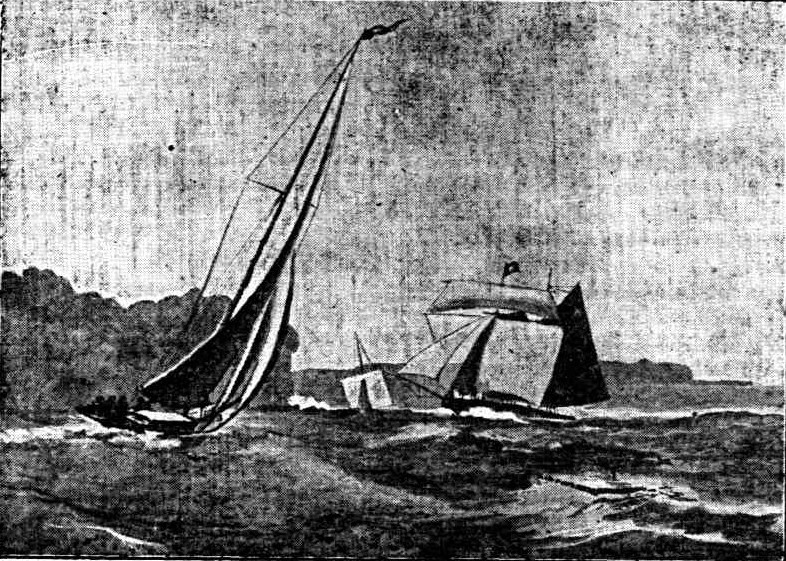
Two of Out Earliest Yachts.(FROM A PICTURE IN THE R.S.Y.S. CLUB HOUSE.)
SHORE GAMES.
Tennis, billiards, and bridge are the shore games of the members. Bowls have been talked of, but if ever they come into vogue the steamer will be kept waiting at the wharf longer than at present. The members will have to finish their games a la Sir Francis Drake. The uniform of the squadron consists of a dark blue serge suit, with black buttons; the cloth yachting cap has a crown and anchor badge, which, however, is of plain and neat design. Even so simple a uniform is not much affected by the members. The dignityof the club is perfectly safe in the hands of its Commodore, Sir James Fairfax, whom the members honor, and love to honor.
THE PRINCE ALFRED YACHT CLUB.
The Prince Alfred Yacht Club, or the premier club, as some of its members are pleased to call it, flies its ensign from the Savings Bank Chambers, where it has rooms, and a fine balcony, sufficiently high above Moore-street to afford a view of North Head. It is a cool and pleasant place during the summer months; and the spacious, well-furnished rooms are comfortable in the extreme. - The P.A.Y.C. has been noted of late years for its lavish hospitality; the steamer outings it gives to its members and their friends every second week during the season are invariably well patronised. A good race to watch from a comfortable steamer, an attentive committee to look after the comforts of the guests, a ripping string-band, and many pretty girls, add to the charm of a down-harbor trip. When the steamer has to follow outside races, the band is omitted, and there are fewer ladies onboard. Mr. Gar. Trouton, one of the members, generally has the looking-after of the guests, and you must not get in his way. 'I have to see that 400 persons get afternoon tea, so just keep the gangway clear,' and without any fuss he carries out his self-imposed task. The club steamer leaves punctually, and in many ways its management reflects credit on those concerned; but the Alfreds start their races in mid-channel, in the very thick of the outward-bound traffic, and there will be a serious accident and an inquest some day. The P.A.Y.C. dates back to 1867, and in 1869 it obtained the warrant to hoist the blue — ensign with the ducal coronet on the lower fly. The club has, at any rate of late years, been strong in the matter of uniform. There is something after all in uniform, as you will find out if ever you play kiss-in-the-ring when a fellow with brass buttons and cap badge is there. The present uniform of the Prince Alfred is very nearly that of a Naval Brigade officer. The P.A.Y.C. was really started to provide sport for a smaller class of boats than those of the Royal Sydney, which held very conservative ideas in those days; it has more than succeeded in its objects, and in yacht-racing it is now a useful rival to the senior club. Mr. Thomas Marshall, its present commodore, would like to see an amalgamation of the two clubs— he is a member of both — but there is room for 'both, and the Alfreds are required, if only to wake up the Royals occasionally. The commodore may not thank the writer for digging up his nickname of 'Old Shellback'; that was how he was known in the days when he sailed many a fine race in the Asteroid. Mr. Marshall is a disciplinarian, and when he takes the chair at a meeting of the members they have to keep to the point, which they have not always been accustomed to doing.
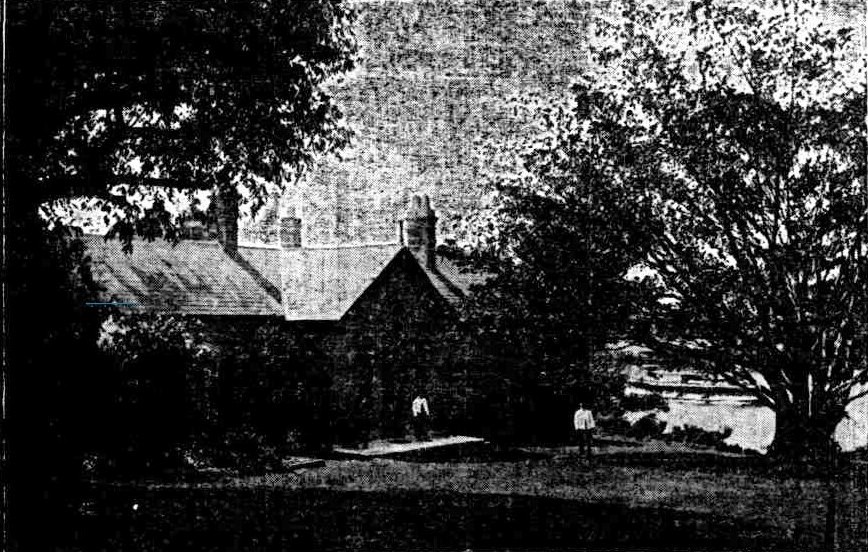
The Royal Sydney Yacht Squadron Club House.
THE SYDNEY AMATEUR SAILING CLUB.
The Sydney Amateur Sailing Club has no place to rest its head. In bygone days its home was at Fort Macquarie, but the Government wanted more wharfage accommodation, and the club had to go out with a very small amount for compensation. Still the club has continued since 1873, and at the present day there is no livelier sailing club in Port Jackson. Certainly its races now are mostly for cruisers— bruise- waters they have been called-but they suit busy professional men, and bring together a number of genuine sports, who will race for a flag with all the keenness they would for a cup. It is a treat to see Judge Fitshardinge rush the line in the Mia, and Mr. David Roxburgh take every ounce out of the Mischief. Mr. Doran, who has attained to far higher racing, loves to have a cut in at his old club. Steamer days, although less frequent in the amateurs than in tie senior clubs, lack nothing to make them thoroughly enjoyable.
OTHER CLUBS.
The Johnstone's Bay Sailing Club is defunct, but the good work it did lives after it. It admitted professionals as well as amateurs to its ranks, and the excellent racing of the real Sydney type of centreboarders drew crowded steamers. The Flying Squadron and the Sydney Sailing Club now do the work of the first named club, and no sailing races seem to interest the general public so much as that of the open boats. The old Balmain Sailing Club, the North Sydney, the Neutral Bay, the Canoe, and many other clubs, were comparatively short-lived. The Sydney Sailing Dingey Club still lives, and flourishes sufficiently even to hold interstate races. The numerous sailing skiffs have been formed into a combination, which can boast bigger fields than any other club here, and its champion is a clergyman, the Rev. J. Cosh. The Motor-Boat Club is handicapped by its gorgeous uniform and its hideous flags, but has many members and many boats, and when it ripens a bit it will no doubt be a valuable institution.
FLAGS
There is an etiquette in flags, although some might not think so after a cruise on the harbor. How often do we see a badly-hoisted ensign, or a vessel carrying a flag she is not entitled to? The writer the other day saw a man-o' -war's steam pinnace chasing an oil launch, which, without warrant, was carrying a blue ensign. The Officer on board the pinnace confiscated the flag, to the surprise of those on board the motor-boat. A somewhat similar incident occurred in the Islands. A trader insisted on carrying an illegal flag, and having recently tarred his rigging, and hailed his colors to the mast, told the lieutenant to take down the offending — that was not the word used by the way — ensign himself. The officer was not to be thwarted so easily. He sent for a couple of axes, and the trader was glad enough to yield (to save his mast. Those who decorate their spars with wild flowers, and those who wear jockey caps, and grotesque uniforms, not only violate good taste, but show their ignorance of nautical affairs, and disfigure the port, of which they should be proud.
THE WORK OF YACHT CLUBS.
It is to be hoped that the clubs here will be able to effect some reforms in such matters; already they have prevented the opening of a coal mine at Bradley's Head, and now they are trying to save for the public some of the foreshores of the harbor. At the rate Sydney is progressing, it will only be a few years before the boating man will no longer have a place to land at, and the public will have no site from which to watch the races or the shipping, if some of the many beautiful spots are not reserved or resumed. The clubs should also endeavor to stop the advertising on water frontages. Nature has made Port Jackson lovely; man is fast making it hideous.
(To Be Continued.)
Two of Out Earliest Yachts.(FROM A PICTURE IN THE R.S.Y.S. CLUB HOUSE.)
The Royal Sydney Yacht Squadron Club House.
PORT JACKSON'S PLEASURE FLEETS. (1907, December 21).Evening News (Sydney, NSW : 1869 - 1931), p. 11. Retrieved from http://nla.gov.au/nla.news-article113896614
PORT JACKSON'S PLEASURE FLEETS. No. 12
BY LANYARD.
'The security of the kingdom is increased by every' man being more or less a sailor.' —Captain Marryat.
A couple of months ago it was looked upon as fairly certain that the Awanui, Mr. Alex. Saxton's beautiful 10-metre cruiser-racer, would do battle for this State in Port Phillip for the purpose of winning the Sayonara Cup. But owing to the Victorians having altered the conditions under which the cup was first won and subsequently competed for, the challenge has been withdrawn, and it is now definitely decided that, for this season at any rate, no attempt shall be made to recover our lost supremacy in interstate yacht racing.
Let us turn to the history of the cup. It will be remembered that the Sayonara, a fine, wholesome stamp of a Fife cruiser, built in Adelaide, but subsequently bought by Mr. A. Gollin, of Melbourne, sailed to these waters in the beginning of 1905 to race for a cup presented by the Royal Victorian Yacht Club and our own senior clubs. No expense had been spared in making the visitor a fit representative of her State, and, with hollow spars, new sails, and a picked and unanimous crew under one of the best, if not the best, skipper in Port Phillip, she thoroughly deserved the confidence placed in her by her partisans.
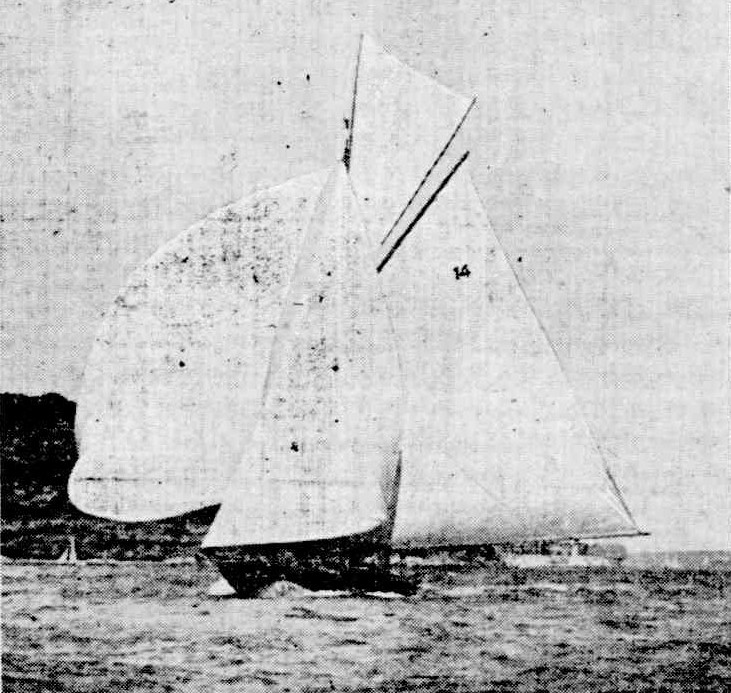
Mr. A. Saxton's Awanui.
The Bona, under the P.A.Y.C. flag, was chosen to uphold the credit of the home State, but after she had been in preparation for sometime there was a change of ownership, a member of the R.S.Y.S. having purchased her. The Bona has always been better at inside than at outside work, especially when the conditions are at all heavy, yet instead of asking for at least one race over an inside course, we seem to have begun by giving way to the Victorians on all points in the negotiations before the start of the race, and have ended by having to give way to them on the course proper; but in the second of the first series of races- it must not be forgotten that the Bona led her big rival from start to finish. At any rate, whatever were the causes, the result was that we were beaten in straight-out sailing on our own waters in two of three races; and the next thing to do was to consider the best means of bringing, the cup to Port Jackson.
This was undertaken by Mr. C. T. Brockhoff, who promptly challenged the Victorians with the Logan designed and built Rawhiti, which had already sailed across the Tasman Sea, and had demonstrated that she was a truly seaworthy craft. Her failure to bring the trophy back with her was keenly felt by the yachtsmen, of this State, for though she handsomely won the La Carabine Cup in a series of three races against all comers, including the Sayonara, the- latter won the match races. Many were looking forward with relish to the meeting between the Awanui and the Sayonara, and it was felt that at last the hour was approaching when our southern rivals would be forced to haul down their flag, and either, have to come back to Port Jackson to try conclusion's or sit down under their defeat. But it was not to be, and when the announcement was made that the new rule would-be rigidly adhered to, no one was more disappointed than Awanui's owner. 'Part L of section .5 of the new international rule; which the Victorians rely on, reads as follows: — 'There shall be no time allowance In races under Y.R.A. rating, except as 'provided in the international rule.'
The exceptions referred to only apply to old boats. Under such a rule the Sayonara's size would give her a tremendous advantage, although many aver that the Sydney boat could beat her off the mark. That may be so, but it is quite time that we refused to knuckle down altogether to the southern yachtsmen in the selection of rules to govern the contests and the withdrawal of the challenge is gratifying if on that ground alone.
Mr. Saxton's contention is that having challenged with a 10-metre yacht, the reply should have been a vessel of the same size or that time should be allowed if they wanted to compete with the Sayonara. - Many, however, think that the Victorians are technically within their rights, but that they appear to study the retaining of the cup rather than the welfare of the sport, and the attempts of our men to meet them half-way or even to go considerably beyond have been unsuccessful. The shutting out of our boats from the Northcote Cup is a sample of the treatment we submit to from the Victorians. So much for the past. But now let us turn to the question of how to proceed in the future. First of all the writer would suggest that before a boat is built for the purpose of challenging, a distinct understanding should be arrived at as to what conditions are to govern the particular contest. When a boat that has reasonable hope of success has been built, let us pick our very best skipper, and let him alone choose his crew.
When the cup is brought up here — as it is to be hoped some day it will be — we should have definite rules laid down to govern these contests — not hard and fast rules that might become obsolete in a very few years, but still conditions that would prevent an enthusiastic sportsman who builds a boat for the purpose of interstate racing, and, under existing conditions, from discovering shortly before the race that he would, have to compete under terms which were expost facto.
PRESENT DAY RACING.
At the present time we find ourselves in the same comparatively unsatisfactory state of mixed yacht racing that we emerged from with the advent of the 30-footer class. The Awanui has already won five races this season; neither the Rawhiti nor White Wings having proved class enough for her even in the handicap events. The remnants of the 30-footers still enter and have a go at each other, with the possibility of their leader getting into a place, and while the club steamer is often miles ahead with the big boats, the little ones sometimes put in some clever and exciting sailing that takes one back to the days when a fleet of these graceful little ships used to provide the spectators and their crews with all the keen competition of class racing. No one doubts for a moment that class racing should be re-introduced, and efforts have been made in certain quarters to reinstate it here on a firm basis; but so far nothing substantial has materialised.
On account, to a certain extent of the condition into which our racing has deteriorated several erstwhile prominent skippers have sought solace in the cosy little coach houseboat that lately we have become so familiar with, or else have joined the ranks of the benzine beneficiaries. It is not to our credit when we come to consider the number of yachts in Port Jackson at the present time, that we have to admit that, outside of the open boats, we have practically no craft which could be formed into a distinct class in sufficient numbers to be successfully raced as such. Surely these matters, if looked into seriously, could be rectified, and the writer would suggest that there is ample scope for three classes. The present day ten metre yachts, of which we only have the one as yet, would admirably suit those who can afford a fairly large type; and the 30-footers, excluding the extreme racing type, have proved themselves very 'well-adapted for both cruising and racing, and would make a suitable second-class, whilst a 24 or 25-foot class might be found to fill the requirements of those who prefer something smaller.
Since the above was written, a move in the right direction has been made by dividing the yachts at present tracing into two classes of ten metres and eight metres respectively, the former division to include those boats exceeding the measurement's which are already on the club register.
This at present can only be a compromise, so different are the boats, but it will probably be the means of introducing new ones, now that would-be builders have something definite to work on. A third class, could very well be formed of the coach-house' boats, than which no other small type is better suited to local conditions.
COACH-HOUSE BOATS.
The Senga is a fine example, and no boat of 25 feet could be safer, more Seaworthy, or more comfortable than this trim little vessel. She combines with most of her kind, all the stability of the old deep keeler, with the handiness and general utility of the fishing boat. The coach-house boats have considerably more camping accommodating and storage space than most other boats half as big again, and when they are at sea their buoyancy and consequent dryness render battening down unnecessary, even in dirty weather, so that their cabins do not greet the visitor with those unsavoury smells which are by no means infrequent in boats that cannot have the same amount of ventilation.
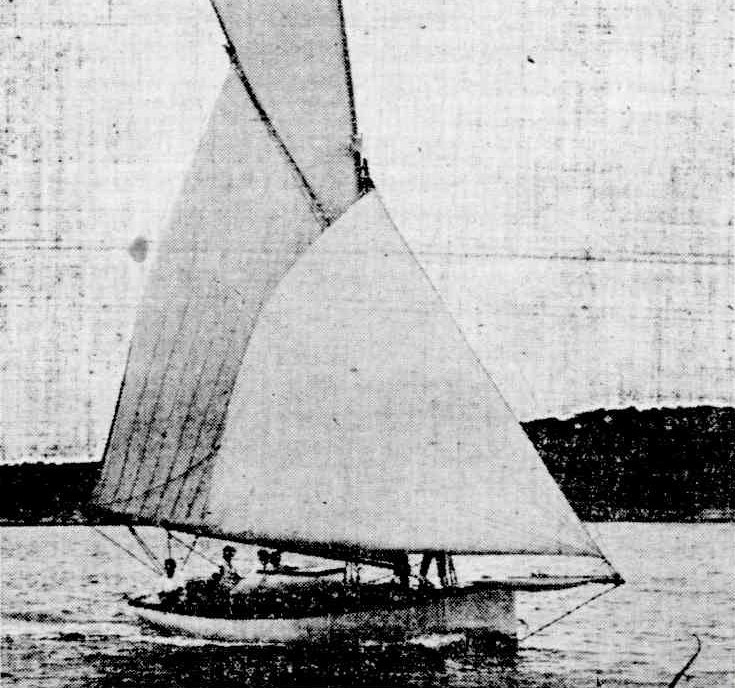
Mr. H. H. Massie's Senga.
Many a little corner along the coast, whose shelter or exploration is out of the question in a deep keeler, is open to these boats, whose draught, of course at the expense of a little head room, is often well under 2 feet with the centreboard up, and in some cases they could be put on the beach like a dingey. Finally, it will be found that these boats, under favorable weather conditions, manage to do fairly lengthy trips without taking the proverbial long time over them; in fact, there are very few, if any, of the present day yachts in Port Jackson, excluding those that have been built for racing, that don't want to have a look at something on the other side of the harbor when the coach-house boat comes along.
THE ADVANTAGES OF SAILING.
Much has been said and much has been written against the love of sport that exists in our community. There is, perhaps, some force in such criticism so far as it relates to the vast majority who are merely onlookers, or 'barrackers,' but it can have no application to those who actually engage in manly sports. If the reader will look in at Quarantine some Sunday during the sailing season, he will be struck by the remarkably fine physique of the young fellows, who, after their sail down the harbor, are swimming in the clear water, playing cricket, or wrestling on the white sands. With proper training these young men would make good defenders of their country, whether as sailors or soldiers. The fatigues they have undergone, the dangers they have had to overcome, the strategy they have had to employ in their races, and the exercise they have taken, will help to qualify them when their services are needed. Sailing is not all lolling about, and the man who says it is shows his ignorance of the sport. Besides it is a clean sport, even in these degenerate days.
In taking leave of his readers, the writer may be pardoned for expressing a hope that sailing may flourish, and that the white wings of the pleasure fleets of Port Jackson will be more numerous than ever. (Concluded.)
Mr. A. Saxton's Awanui.
Mr. H. H. Massie's Senga.
PORT JACKSON PLEASURE FLEETS. (1907, December 28).Evening News (Sydney, NSW : 1869 - 1931), p. 3. Retrieved fromhttp://nla.gov.au/nla.news-article113895516
Charting the Voyages and Name Changes of Classic Wooden Yachts can take some perseverance for the below reasons:
Awanui-A New Yacht.
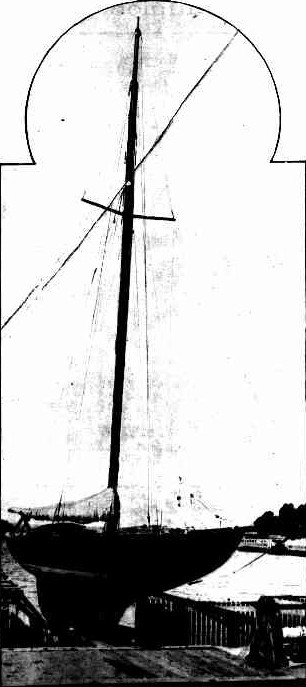 Mr. A. C. Saxton the vice-commodore of the Prince Alfred Yacht Club, has in Awanui one of the most graceful boats on 'Sydney Harbor. She is the pioneer of the new 10-metre class, and' is quite up to the reputation -of the celebrated designer, Fife. She was built at W. M. Ford's yard at Berry's Bay, a fact of which Mr. Saxton is proud. He says it shows we had as good material and workmanship here as in any yacht building centre. The dimensions of the new yacht are:- Length over all, 50ft 10in; water line, 33ft 71n; depth, 6ft 8in; beam, 7 ft 4in. The Awanui was constructed on the grown frame principle, with Intermediate steam-bent timbers. The planking is of cedar, with Huon pine garboards. Steel floors and straps are used to tie the heels of the frame together. The deck is of very narrow kauri planking. She is painted black above and green below the water. The supervising architect was Mr. E. W. Heywood.
Mr. A. C. Saxton the vice-commodore of the Prince Alfred Yacht Club, has in Awanui one of the most graceful boats on 'Sydney Harbor. She is the pioneer of the new 10-metre class, and' is quite up to the reputation -of the celebrated designer, Fife. She was built at W. M. Ford's yard at Berry's Bay, a fact of which Mr. Saxton is proud. He says it shows we had as good material and workmanship here as in any yacht building centre. The dimensions of the new yacht are:- Length over all, 50ft 10in; water line, 33ft 71n; depth, 6ft 8in; beam, 7 ft 4in. The Awanui was constructed on the grown frame principle, with Intermediate steam-bent timbers. The planking is of cedar, with Huon pine garboards. Steel floors and straps are used to tie the heels of the frame together. The deck is of very narrow kauri planking. She is painted black above and green below the water. The supervising architect was Mr. E. W. Heywood.
Awanui has only been afloat three weeks. Still she has succeeded in finishing secondiIn her first race and first in her second. Rather a good beginning. Shortly she will meet Rawhiti in three test races, and it is said the results will have a bearing on the next challenge for the Sayonara Cup. Awanui—A New Yacht. (1907, February 27). Australian Town and Country Journal (Sydney, NSW : 1870 - 1907), p. 20. Retrieved from http://nla.gov.au/nla.news-article71589819
She was launched Tuesday February 5th, 1907: SAILING. (1907, February 6). The Sydney Morning Herald(NSW : 1842 - 1954), p. 12. Retrieved fromhttp://nla.gov.au/nla.news-article14850400
Name change:
AWANUI STARTS ON LONG VOYAGE.
The Sydney yacht Culwulla II. (late Awanui) left Rasmusssen's shed, Rushcutter's Bay, this afternoon, for Hobart and Melbourne; to represent New South Wales in Tasmania, and Melbourne. She is the challenger for the Sayonara Cup. Mr. Walter Marks, owner of the yacht, is in command, and with him are Messrs. W. Moore, W. Adams, Neilson, and another.AWANUI STARTS ON LONG VOYAGE. (1910, February 3).Evening News (Sydney, NSW : 1869 - 1931), p. 5. Retrieved from http://nla.gov.au/nla.news-article116052104
In 1910 Mr W Marks of RSYS issued a challenge with his yacht Awanui and then renamed Cullwalla III (should be II) (Now named Eun-na-mara)
She is currently for sale! See here